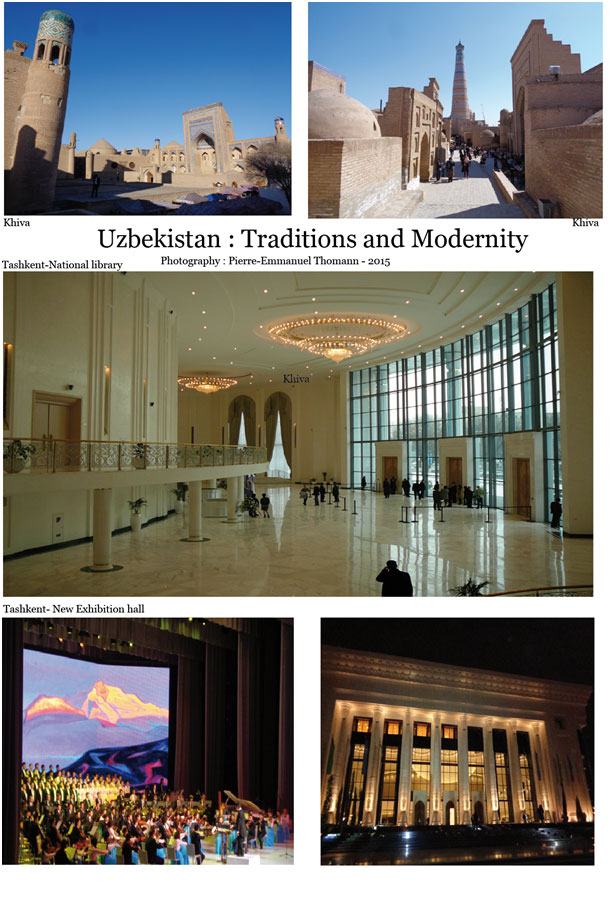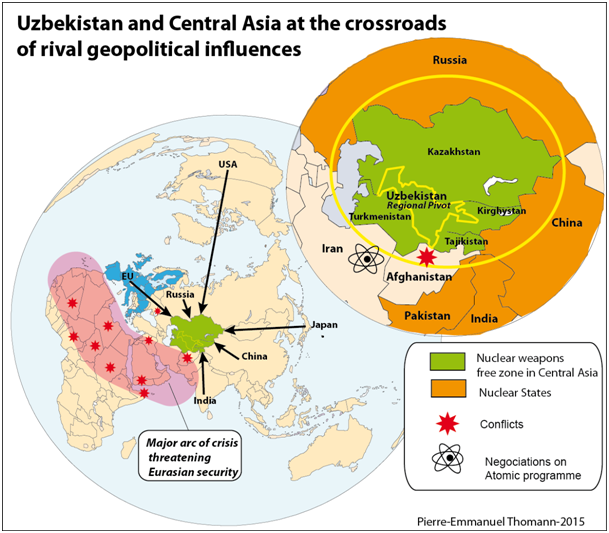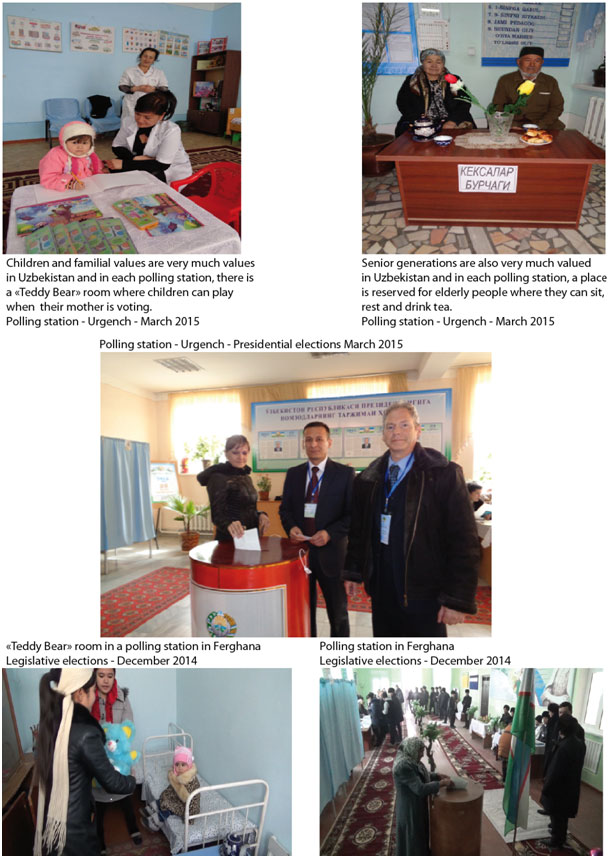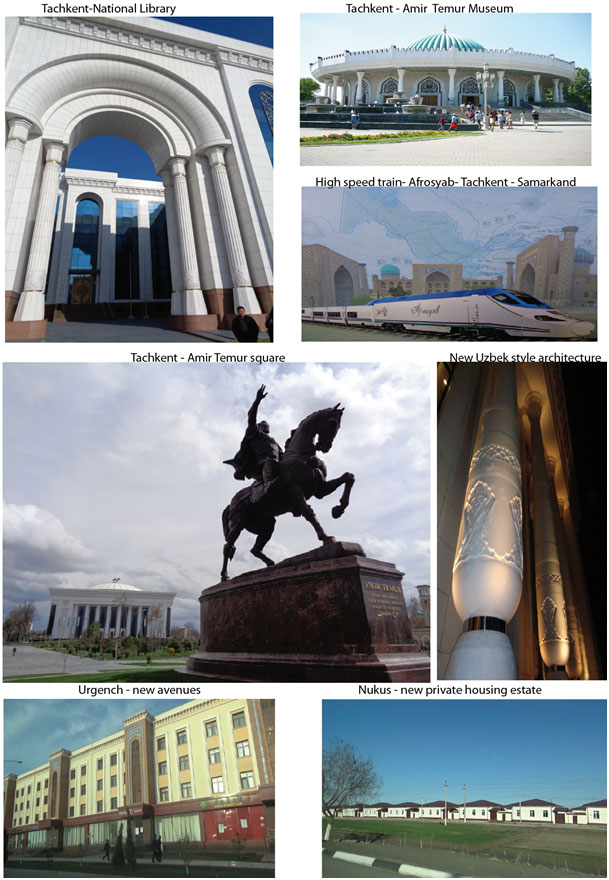Presidential and parliamentary 2014-2015 elections in Uzbekistan: geopolitical stability is in European interest
The years 2014 and 2015 have been marked by important elections in Uzbekistan as the legislative elections took place in December 2014 and the presidential elections in March 2015. The President Islam Karimov was re-elected for the 4th time since 1991 after the presidential elections on the 29th of March 2015. The electoral results for Islam Karimov were very high as he obtained a score of more than 90% of the votes. The level of participation was also very high as it reached more than 90 %. This re-election followed the parliamentary elections (Parliament, Oliy Majlis, is a bicameral body composed of the Legislative chamber and the Senate) on the 21th of December 2014. The results for the Legislative Chamber (150 seats) had already shown support for the party supporting the president with the best results obtained by the Movement of Entrepreneurs and Businessmen "Liberal Democratic Party of Uzbekistan" (52 seats), followed by the Democratic Party of Uzbekistan "Milly Tiklanish"(36 seats), the People's Democratic Party of Uzbekistan 27 seats), and from the Social Democratic Party "Adolat" (20 seats). 15 Member of Parliament are also reserved for the ecological movement to raise ecological awareness on the basis that ecological problems don’t wait (like women quotas in some European electoral systems). These types of electoral scores are unseen in Europe and this is why it is difficult for Europeans to understand the political meaning of this election as they mistakenly compare this to the political situation in Europe. In order to make more sense of these elections, we have to examine the specific historical and geopolitical situation faced by Uzbekistan.
The internal and external geopolitical challenges
We cannot compare Uzbekistan and European countries without to take into account the specific historical and geographical factors influencing Uzbek society and politics.
Uzbekistan is in a process of nation-state building and modernization after its very recent independence. It could be compared for example with the modernization of European countries after World War Two, although Uzbek independence didn’t originate from war. Moreover, European countries were independent before, but not Uzbekistan. The challenge is therefore even more important. Uzbekistan needs long term geopolitical stability to achieve its modernizing path.
Uzbekistan was a peripheral territory of Soviet Union and acquired after independence a more central position with the end of bipolarity and the emergence of a multipolar world. Uzbekistan is now surrounded and courted by strong state powers competing for geopolitical influence. This situation can bring advantages as opportunities emerge from all directions, but the balance of interests of international partners has to be constantly and carefully measured. Uzbekistan is at the same time under direct threat as a front-line state bordering the conflict in Afghanistan. To preserve its sovereignty, security and reach prosperity, the Uzbek state has developed « realpolitical skills » with a doctrine of multivectorial foreign policy, similar to the balance of power. It is the more adapted posture to position itself in a highly volatile region.
Uzbekistan faces different challenges:
There is a major external challenge as Uzbekistan is geographically situated in the crush zone of two converging arc of crisis. The arc of crisis on the Southern flank of Eurasia (from Sahel in Africa to Afghanistan) is characterized by political destabilizations with domino effects that ill-conceived Western policies have made worse by provoking regime changes leading to civil wars (see geopolitical map above). This has facilitated the access to power or the reinforcement of extremist Islamist forces. This Southern arc of crisis is overlapping another arc of crisis from Arctic Sea to Afghanistan deriving from the conflicts resulting from the fall of USSR and the posture of Russia resisting Islamist and euro-Atlanticist expansion for its own security.
Central Asia is a landlocked region. Central Asian states have no access to open seas and are consequently dependent on neighbouring countries for commercial and energy imports and exports. Uzbekistan is the only doubly landlocked country in the world as it is separated from open seas by at least two countries.
The central position of Uzbekistan in Central Asia can both be an asset or a drawback. In troubled times, it can be surrounded by hostile states and be drowned into changing alliances in all directions. In time of peace, its central position can foster exchanges in all directions.
Uzbekistan is the location of the largest population of the region and Uzbek minorities live in Afghanistan, Tajikistan, Turkmenistan, and Kazakhstan. Uzbekistan is also hosting many ethnic and religious minorities (Uzbeks represent 80 % de la population. Minorities: Tadjik, Russian, Kazakh, Tatar, Karakalpak, Kirghiz, Korean, Turkmen, Armenian, Azeri, Ukrainian, Yiddish, Ouïgour, Bachkir, Farsi…).
These characteristics can bring a strong regional advantage as it constitutes a potential capacity of projection of influence, but also a risk if they are instrumentalized by hostile external powers or violent Islamist political opposition.
Another big challenge is demography with a doubling of population (28 millions) since 1979. The tremendous proportion of young people among total population is also an asset for the long term, but economic policies have to deliver sustainable growth and employment.
The building of a nation-state on a territory characterized by geographic and ethnic diversity and a strong demography requires strong policy tools from the state to achieve internal cohesion. All these geopolitical particularities of the region are driving Uzbek citizen towards a strong state. It also requires a stable political leadership that can protect citizens as global security (military, economic, identity) is the first common good in all societies, and security in a country bordering Afghanistan is even more valued.
The specific historical cycle of Uzbekistan explain the popularity of its political leadership.
There are also other internal factors explaining the popularity of the current Uzbek political leadership. Among Uzbek citizens, there is a widespread sense of admiration and thankfulness to Islam Karimov as they compare where Uzbekistan is now and what was Uzbekistan at the time of its independence in 1991 and it demonstrates a real progress. Uzbekistan is a different historical cycle than European Union countries and this modernization cycle led by Islam Karimov is comparable to political leadership in Europe just after the Second World War.
This popularity comes from the achievements made during his presidency.
Both for Uzbek citizens but also for many external observers, the changes over time is very impressive : new infrastructures were built at high speed and they are emerging all over the country : not only in the capital city Tashkent but also in Samarkand, Bukhara, Fergana, Urgench, Nukus….
These new infrastructures are new cultural centres, administrative buildings, schools, universities, public parks, monuments but also new urban districts and also new private housing estates. They are emerging from the ground in renovated districts or new cities with a mixture of modernity and traditional Uzbek architecture. Transport infrastructure is also improving: Uzbekistan is the first country to have built a high speed train between Tashkent and Samarkand, the « Afrosyab train ». New highways are also under construction like the connection between Urgench and Nukus.
The difficult transition from a planified economy to a more open and liberal model requires also strong state intervention to guide the policy decisions and implement economic modernization. Substitution strategies to importations to achieve self-reliance in energy matters and food production are also a success for the sovereignty of the country. The economy, heavily reliant on cotton and energy exports at the time of independence was gradually diversified (in 1992, cotton represented half of exports and now around 17 %) and manufactured products increased (Uzbekistan is among the only 30 countries in the world producing trucks and cars, UzdaewooAuto and Samauto).
The strategy of the government was also to give priority to productive long term investments from various countries and to refuse short term gains with a containment of the financial speculative products at the source of the world economic crisis since 2008.
The way modernization has been led pleased the majority of the citizens by mixing « step by step » modernization and social protection, with the state as the main reformer. The underlining philosophy is to make progress in all sectors but keep traditional culture vivid, developing a strong sense of national identity and preserving sovereignty. This model of modernization called the « Uzbek model » is mixing modernization and traditions. The Uzbek model of economy, media development, democracy in evolution and education policy combining in a subtle way traditions and modernity needs stability but also legitimacy to succeed.
The preservation of culture and the reconnexion of Uzbekistan to its rich historical ancient civilization are seen also as a very good achievement from these successive presidencies. Handicrafts, but also traditional music and dances are popular everywhere all over the country and this is not only valuable for the national identity of that country, but also for the development of quality tourism with many UNESCO heritage sites on the ancient Silk Road routes.
Each country has the right to build its own democratic model.
We have to remember that Uzbekistan is a very young country and it never experienced democracy as an independent state, and is rightfully building its own model according to its own identity, history, geography.
Implementing a purely Western like model of democracy and an economic « shock therapy » would just make imbalances worse. The imposition of a purely Western style democracy (is there one? each European country has its own model) would bring new fractures to the country and political leadership would loose legitimacy. The hope for Westernization in Irak after the Irak war and in Egypt, Libya, and Syria following «Arab revolutions» is a striking example of Western illusions, wrong geopolitical diagnosis and policies that bring worst situations than the previous political and economic situation
Democratic models should not be understood through rigid theoretical norms and procedures. Subtle balance between International norms and national requirements according to the specificity of culture/traditions history and geography are needed.
All these factors highlighted in this article make the Uzbek elections somewhat different from European elections, but similar in the sense that elections have to give a legitimate mandate to political leaders.
The main differences are also:
– A higher rate of participation in Uzbek elections as democracy is younger compared than electoral participation usually in decline in Europe.
– Election days is like a national celebration in Uzbekistan as elections in Europe are more a political/technical event.
– Uzbek Democracy is less confrontational than in Europe as there is large consensus between different political parties to achieve rapid modernization through strong political leadership and avoid « political balkanization ».
– The model of democracy in Uzbekistan is more based on the preservation of traditions than in Europe as Uzbek society is more traditional.
– There is today no credible alternative of political leadership in Uzbekistan.
Conclusion: Europeans should promote stability in Uzbekistan
The political leadership in Uzbekistan uses the following quote to justify its “step by step” approach: “Don't destroy an old house before you build another.”
Political stability and not ideology should prevail to achieve stability on the Eurasian continent. Dreams of Westernizing the Eurasian continent after the demise of USSR as it was experimented until recently should be abandoned because it simply doesn’t suit nor European nor Uzbek long term stability interests. The Uzbek model of democracy, economy, media liberalization, and education policy combining in a subtle way traditions and modernity needs stability and local legitimacy to succeed.
Future challenges are difficult to face as globalization is a carving up of geopolitical spaces between powers and can have very destabilizing effects in terms of security, economy and access to energy. The Eurasian continent constitutes the new geopolitical zone of manoeuvring for these competing powers because of its size, demography, minerals resources and geopolitical constellation.
The European Union must not find itself marginalized in the alliance building process taking place in Eurasia in an adjustment process between powers towards a multipolar world. European countries have an interest in having Uzbekistan, a pivot country in Central Asia succeed its transition and modernization. The potential destabilization of Central Asia from the precarious situation in the Afghan conflict might also destabilize the whole Eurasian continent and Europe would be further squeezed between the Southern arc of crisis and new fractures on its Eastern flank.
The best systems of defence are concentric lines constituting different lines of defences to prevent instability pervading from zones of conflict and “failed states“. Concentric lines of defence are a necessity since the front lines are permanently moving in space and time and strategic depth is important.
The civilian and military operation in Afghanistan constituted the first line of defence against instability threatening the Eurasian continent and world security: the results were however far from optimal because the interests of neighbouring countries were not enough taken into account.
With the departure of NATO and the risk of geopolitical vacuum, the stability of front-line states bordering the zone of conflict becomes even more important and they can directly affected by any spread of instability. Then, the whole area of Central Asia bordering Afghanistan constitutes now a line of defence of continental importance against instability.
EU countries and Uzbekistan are also facing many common challenges: both have to face globalization with new opportunities but also bad aspects. The « New Silk road » projects and its different routes across the Eurasian continent could improve Uzbek economy weakened by its landlocked status and achieve more exchanges with new physical links between Europe and Central Asia.
Both European countries and Uzbekistan have a very ancient civilization. This is why they should keep vivid their heritage and learn from each other. Europe should learn again how to keep alive its traditions within the European project. Only nations proud of their past and determined to master their destiny will survive in a multipolar and confrontational world. The choice to build a strong nation-state rooted on strong national identity is an asset in the context of globalization and rapid change.
Uzbekistan can be a valuable partner for Europe to promote a eurocontinental area of security and prosperity and achieve a better balance of interests in the Maelstrom of globalization.
Dr Pierre-Emmanuel Thomann, director of research in geopolitics, IERI, Brussels, founder of www.eurocontinent.eu.
International observer/presidential elections (29 March 2015) and parliamentary elections (December 2014).



